Tach Attack!
Original Posted July 2009
Update posted July 2016 and
updated June 2017
Eventually, I had to bite the
bullet.
I'd been fighting tachometer problems in my Fly Baby since
February. It started out as a major-league shaking of the
needle. I'd pull the drive cable out, lubricate it, and
the tach would work fine on the next flight and be back to its
old tricks the flight after that.
And it got worse. Pretty soon, the tach needle would shake
a while, then just drop down to zero.
That got to be the litany, for about six months. I'd make
a change, and for the next flight or two, the tach would work
perfect. Then the same problems reappeared.
I tried everything, from a new tach (actuall, a borrowed used
one) to a new tach cable. With everything else pretty much
eliminated, the worst-case scenario was about the only one
left: The tachometer drive on the back of the engine was
bad.
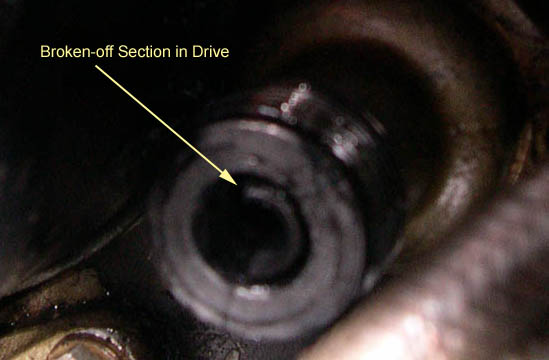
An out-of-focus, grainy digital camera
picture seemed to show the center drive section broken in
half. Problem confirmed.
All right…now what?
My first inclination was to
get the tach drive itself fixed. But the tach drive is
part of the oil pump idler gear, buried in the accessory
case in the back of the engine. I took a few moments
to contemplate what that meant: To replace it, I'd
have to remove the engine from the airplane, remove the
starter, generator, and both magnetos from the back of the
engine, then remove the entire accessory case to get at the
oil pump gears. And, of course, reassemble everything,
with a high preference to having things working properly
when I got done. And, frankly, I'm not really
qualified to break down an engine that far. To have it
done would probably run into a thousand dollars or more.
I started looking into the possiblility of an electronic
tach. It was mostly disappointing. Most installed a
transducer on the engine tach drive...which I figured
wouldn't work in my case, since they probably would have the
same problems with my damaged drive head. Others connected
to a Bendix or Slick magneto...neat option, but I have
Eisemans.
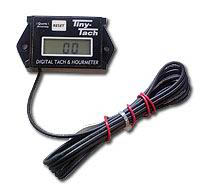
Finally,
I noticed the "Tiny Tach" on the
Aircraft
Spruce
web page. Seemed pretty good...got its signal by
wrapping a wire around a spark plug cable. From the
description, I wasn't completely sure which model to
buy. But when I went to the manufacturer's web page, I
found they had a universal "Commercial" model that also
updated faster than the standard units.
Only $65, so I went ahead and ordered one. It had
both a tach function as well as an hourmeter and two
service timers. It didn't need ANY other connection other
than to wrap the sensor wire around a spark plug cable. It
has a built-in battery.
When it came in, I went to the airport and tried a
temporary installation. No go...tach read zero. I
suspected the shielding on the tach cables, and a call to
the tach vendor confirmed it. The tech recommended peeling
the shielding back near a plug, but I didn't want to run
my tach wire out into the slipstream.
One of my spark plug wires is about 9" too long, and a
previous owner had wrapped up the excess and tie-wrapped
it to the engine mount. I figured I'd modify the
wire there, so if I botched it, there'd still be enough
cable to connect to the mag. So I picked at the shielding
with a toothpick to make some openings, then carefully
plucked away at it with an exacto knife. A few minutes
work, and I had a 1" long section of cable free of the
braid. (Note: More-modern plug wires may not
have this external braid!)
The tach instructions said to wrap the red wire around the
cable 3-4 times. The tachometer worked, but the idle was
erratic. I eventually added a couple of extra turns
to make the reading more stable.

I made a mount for the Tiny Tach from some leftover 1/8" plywood.
I could have just used a flat sheet to attach behind the panel,
but I ended up with a "sandwich" construction where the outer face
was circular with the diameter just less than a standard
instrument hole. I felt this gave a lot nicer look to the
installation....it looked more like an instrument sitting "in the
hole" than just a flat sheet behind.
One thing I had to do was plug off the old tach cable port on the
back of the engine. Aircraft Spruce had a cap for Lycomings that
had the same thread sizes, so I took a chance that it'd fit my
Continental.
It did, but the hardest part was safety-wiring it in place. The
cap sits between the generator and the right mag, and there aren't
any good places nearby to connect the safety-wire to. I finally
settled on a fitting eight or so inches away, and fed in a long
piece of safety wire through pre-drilled holes in the end of the
cap.
I was wiggling the wire around, trying to curve the other end back
around, when I heard a crackling sound. I stepped back and saw
smoke rising. The loose end of the safety wire had flipped up and
had shorted a +12V terminal to ground!
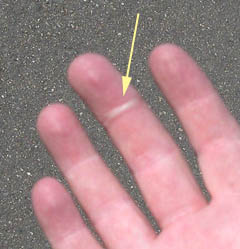 Problem solved...but now I had a nice little
burn-blister across the last joint of my middle finger.
Problem solved...but now I had a nice little
burn-blister across the last joint of my middle finger.
The cap was finally safetied, and I ran the tach wire ran over the
same route as the old tach drive cable. Wrap the red sensor
wire around the open area between the braid four times, then
lay the sensor wire parallel to the spark plug wire and wrap the
whole area in copper tape. I was concerned about the
open braid causing radio noise.
No radio noise...but no operation of the tach, either.
I figured it was the copper tape, so I stripped it away and
straightened the sensor wire. That got things working again.
I'd brought a headset with, and noticed that the open section in the
braid produced only a very minor bit of popping into the
radio. But I'd started to wonder if maybe my copper tape
wrapping HADN'T been the problem, earlier. I had laid the rest
of the sensor wire horizontally along the plug wire under the copper
tape. The diagram from the tach manufacturer shows the sensor
wire coming straight away from the plug wire, instead. So I
re-wrapped the section with copper tape, taking care to let the
sensor go directly away from the plug wire instead of wrapping it in
the copper tape.
And lo and behold, it worked.
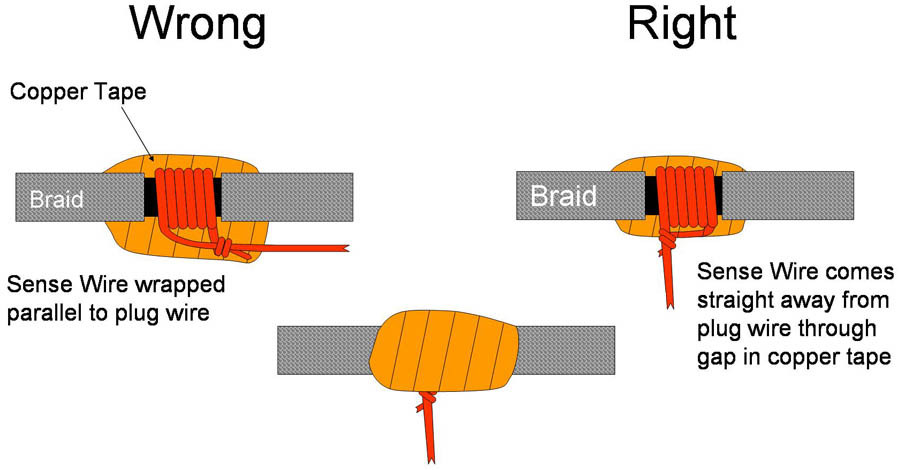
I wrapped the area with electrical tape for a bit of
durability. Finally, the loop of spark plug wire was tied back
the way it had been, against a tube of the engine mount with
tie-wraps.

Since it's connected to the left magneto, conventional "Mag checks"
are a thing of the past. When the mag switch goes to "R", the
tach goes to zero...it can't register if the magneto isn't firing.
I don't see this as much of a drawback. I've been less
concerned with the actual RPM drop during a mag check than with
rough running, instead. I figure that any real problem will
manifest itself as missing and stumbling, rather than hitting 155
RPM on a mag drop.
In any case, I own a small handheld tach, and will use it at annual
time to make sure things are hunky-dory.
The hourmeter function is pretty slick; it registers hours until the
engine starts, then automatically switches to the tach mode.
However, the hour meter shows hours and minutes only until the tach
reaches 199:59; after that, it reads whole hours only.
Not a real drawback, as the tach also includes a secondary counter
that can still be used to keep track of minutes. However, 200
hours is about five years of flying for me, and the built-in battery
of the Tiny Tach is only good for 5-8 years. At that point,
I'd better hope the company is still operating...or come up
with some other solution.

Update - July 2016
Well, all good things must come to an end. I installed the
original Tiny-Tach in July 2009, and by late 2014, the display was
starting to get a bit faded.
But...shoot, it still worked. So I ordered another one as a
stand-by, but left the old one in place. Surprisingly, it
held on for another year and a half. Two weeks ago, it was
very, VERY faint (but readable). But by the end of my last
flight, it was completely dead.
Pretty good, really. The company guarantees five years
(which is about when it started to fade), but I got seven years'
service out of it.
First decision was whether to install the one I'd ordered
earlier. They were good for five years, and this one had
already used up almost two years of life.
I decided to make life easier and install a connector at the
spark-plug-wire-wrap. That way, I figured, I could just
quickly set up and install a new one if this one goes bad.
Plans shattered with trying to run the cable for the new
tach. I could NOT get it to feed from the cockpit. I
eventually had to remove the top cover forward of the cockpit to
get access to the run. With that, though, it was easy.
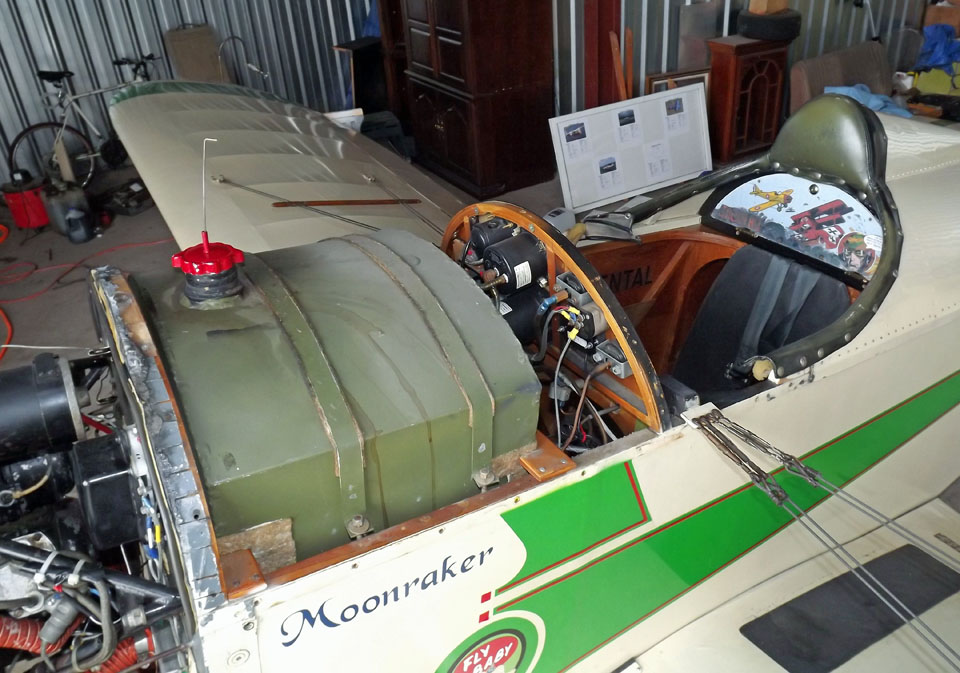
Super easy to finish the run, here.
But when I got things forward, I started to re-think the connector
idea. Replacement of the Tiny Tach wasn't going to be as
simple as I desired. Why take a chance on the connector
messing things up totally.
As it turned out the old plug-wire wrap was easy to remove.
The new one was easy to apply, but for some reason, the gauge didn't
work!
Not sure what happened. Maybe the application of the copper
tape interfered with it. Or...maybe the Tiny Tach design had
changed a bit. I tore everything open again, and started from
scratch...and found I needed only half the number of wire turns I'd
had before. The instructions caution that too MANY turns can
cause issues. Don't know if it was just my installation, or
the new gauge is more sensitive.
In any case, the fewer turns appear to have done the trick.
It's working now.
On Tiny Tach Battery Replacement
(added June 2017)
I had originally intended to cut open the old Tiny Tach and
investigate methods of making the battery replaceable.
Decided against it for one main reason: As I mention above,
when the hourmeter on the tach passes 200 hours, it counts ONLY
whole hours rather than hours and minutes. Frankly, that's of
little use to me, and my tach had enough hours that I'd have to deal
with it in a year or so.
I do have an old Hobbs meter; considered using that to keep track of
hours instead. But I like the cleaner approach of just
replacing the whole unit.
 Return to the Tech Page
Return to the Tech Page
 An out-of-focus, grainy digital camera
picture seemed to show the center drive section broken in
half. Problem confirmed.
An out-of-focus, grainy digital camera
picture seemed to show the center drive section broken in
half. Problem confirmed. Finally,
I noticed the "Tiny Tach" on the Aircraft
Spruce
web page. Seemed pretty good...got its signal by
wrapping a wire around a spark plug cable. From the
description, I wasn't completely sure which model to
buy. But when I went to the manufacturer's web page, I
found they had a universal "Commercial" model that also
updated faster than the standard units.
Finally,
I noticed the "Tiny Tach" on the Aircraft
Spruce
web page. Seemed pretty good...got its signal by
wrapping a wire around a spark plug cable. From the
description, I wasn't completely sure which model to
buy. But when I went to the manufacturer's web page, I
found they had a universal "Commercial" model that also
updated faster than the standard units.
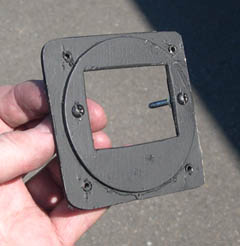
 Problem solved...but now I had a nice little
burn-blister across the last joint of my middle finger.
Problem solved...but now I had a nice little
burn-blister across the last joint of my middle finger. 



 Return to the Tech Page
Return to the Tech Page